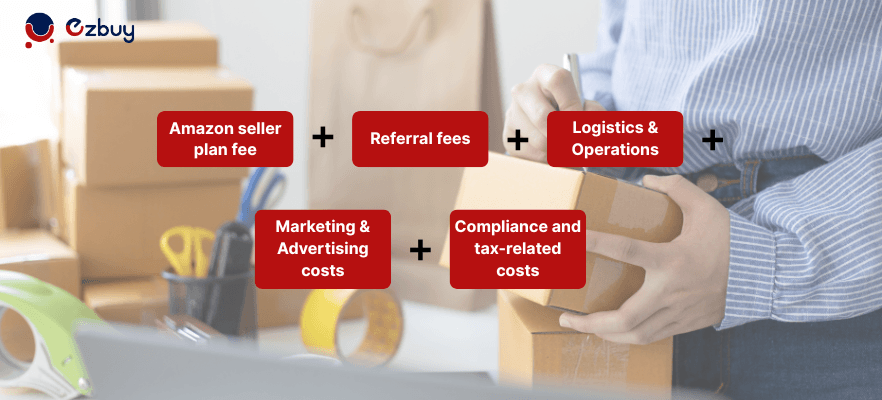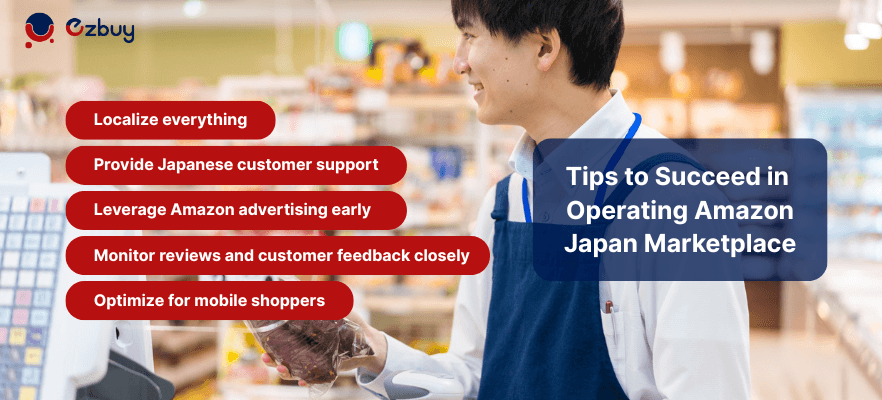Operating Amazon Japan Marketplace – Ultimate Guide For Sellers
By Macy -21/04/2025 UTC.
The third-largest economy in the world, Japan is an e-commerce-ready, quality-focused consumer market, and an ideal place for companies from outside Japan to seek e-commerce expansion. Operating Amazon Japan marketplace successfully allows foreign sellers to enter this developed and profitable market.
For international sellers, selling on Amazon Japan isn't selling to an additional market of customers - it is selling to an e-commerce market that is continually expanding. Amazon Japan saw 611.4 million website visits in June 2024, which represents about 8.93% of Amazon's overall global traffic (World Population Review). That means Japan represents an enormous untapped potential for sellers who can localize and optimize.
Whether you have an existing business or you are an independent entrepreneur, understanding how to work effectively in this market can give you a sound competitive edge.
1. Why sell on Amazon Japan?
Expanding to Amazon Japan taps into one of the globe's most lucrative and stable online shopping markets. Here's why an ever-larger number of merchants is making its next big gamble in Japan!

Fulfillment by Amazon makes it easy
Amazon has more than 20 fulfillment centers in Japan, so sellers don’t need to worry about storage, fulfilling orders, shipping, and even returns. Amazon does it for you. Merchants are free to focus on marketing and selling strategies to expand the market.
Less saturation compared to Western markets
Whereas Amazon US and EU markets have become extremely competitive and saturated, Amazon Japan remains less competitive for almost every niche, primarily product niches such as health and beauty products, outdoor and lifestyle items, specialty foreign products, and specialty hobbies and collectibles.
Lower saturation also makes it easier to be found and rank highly in search engines, especially if your service or product is answering an unfulfilled need in your area.
Japanese shoppers love Amazon Japan
Amazon Japan stands of the top 3 ecommerce platforms in the country, which means that sellers may reach a huge number of loyal customers. Buyers prefer Amazon Japan because it delivers reliable customer service, fast shipping, and highly trusted customer reviews.
2. How to start operating Amazon Japan marketplace
Beginning on Amazon Japan may seem intimidating at first, given the language and cultural differences, but with the right setup and plan, it is very achievable. Below is a simple guide to help in a successful launch:
2.1. Create a seller account on Amazon Japan
You can register through Amazon Global Selling and add Japan as a marketplace, or go directly to Amazon.co.jp Seller Central.
Choose between an Individual or Professional selling plan base on your business model. The Professional plan often comes with more tools and reporting features.
2.2. Complete identity and tax verification
To sell in Japan, you’ll need to go through Amazon’s standard identity verification process. Be ready with:
- A valid business registration (or personal ID if you’re a sole proprietor)
- A credit card
- A utility bill or bank statement (for address verification)
Also, register with Japan's Consumption Tax (JCT) if you exceed the threshold. It's normally best to engage a local tax advisor to assist you in complying and avoiding future penalties.
2.3. Localize your product listings
Success in Japan depends heavily on localization - and not just translation. Japanese consumers expect professional, native-sounding listings. Terrible translations will damage your credibility and kill conversions. Therefore, a native Japanese copywriter or Amazon's listing translation services would be ideal. Furthermore, sellers should use localized keywords based on Japanese search habits, and the listing format should cater to Japanese preferences.
2.4. Set up fulfillment strategy (FBA or FBM)
Fulfillment is critical while selling, even more so when selling on Amazon, which requires a rigorous fulfillment SLA. You can go with Fulfillment by Amazon (FBA), in which Amazon takes care of warehousing, shipping, customer service, and returns. As a less expensive option, sellers can fulfill the orders themselves (fulfillment by merchant - FBM) or outsource to a third-party logistics company to do that.
2.5. Launch & optimize
Once your listings are live, there are three areas that sellers should be monitoring:
- Running Amazon Advertising (PPC) campaigns targeting Japanese consumers
- Collecting good reviews (ask politely using Amazon's Request a Review button)
- Monitoring feedback and adjusting your strategy on a regular basis
Visit Seller Central Japan often to view what's new, buyer messages, and performance data. The more you understand buyer behaviors, the more you can tailor listings and products for the marketplace.
>>> Read more: How To Sell On Amazon Japan: A Complete Guide For Beginners
3. Fulfillment options in Japan
There are two main fulfillment options available to sellers, which are Fulfillment by Amazon (FBA) and Fulfillment by merchant (FBM). The way you fulfill your packages will impact not only the shipping speed but also the operational efficiency, cost, and ability to scale. So, what fulfillment method should sellers choose to suit their needs and budgets? Let’s break it down below!
3.1. Fulfillment by Amazon (FBA)
With FBA, you send your products to Amazon fulfillment centers in Japan and let Amazon handle the storage, packing, shipping, customer service, and return processing.
Prime eligibility
One of the greatest advantages of selling through Fulfillment by Amazon in Japan is being part of the Amazon Prime program. This opens up a wonderful prospect of having your products included in the Prime stock of Amazon, not only enhancing visibility but also more efficiently building trust and loyalty in customers. Japanese consumers are highly loyal to the Prime program, and this makes your products more attractive and likely to sell.
Faster shipping
Japanese consumers have extremely high demands concerning delivery time and would anticipate next-day delivery of their orders. With Amazon's extensive in-country logistics network in Japan, you could happily fulfill these expectations. With FBA, your goods are stored closer to the buyers, available for fast and efficient shipment, driving customer satisfaction and loyalty.
Japanese customer support handled by Amazon
Customer support and return handling can become a problem in a foreign market, especially if you are not physically located in the country. FBA solves this by providing native-language customer support and handling returns on your behalf. It is a handy service in that it provides the timely, quality support customers want in their native language while you get to focus on business development.
3.2. Fulfilled by merchant (FBM)
Fulfillment by merchant means that merchants have to take the fulfillment process by themselves, from storing products to handling and shipping the goods to buyers.
More control over inventory
With Fulfilled by Merchant (FBM), you retain full control over shipping and inventory. That means you can keep your inventory levels as needed according to your business needs, maintain your own shipping policies, and more easily adjust to market or demand changes. For businesses that prefer hands-on management, FBM offers the flexibility to tailor fulfillment strategies to specific business goals.
Potentially lower fees for low-volume sellers
FBM can also be more cost-saving for merchants with lower sales volumes or niche products. By not incurring FBA fees - such as storage, fulfillment, and long-term inventory fees - you can potentially retain healthier profit margins, especially if you have a logistics system in place already. This also renders FBM a more attractive choice for small businesses or startups that are introducing new products to the Japanese market.
Flexibility in packaging and branding
Unlike FBA, where you have no idea in how products are shipped and packaged, FBM allows you to develop brand-specific packaging that appeals to your company's personality. This can have a profound effect on customer perception, promote brand loyalty, and provide a lasting unboxing experience that sets you apart from others.
3.3. FBA vs. FBM: A Quick Comparison
4. Costs of Operating Amazon Japan Marketplace
Selling on Amazon Japan comes with its own special cost factors one needs to prepare for in a thorough manner. Although the cost structure tends to be the same for other Amazon stores, Japan stands out in its own distinct way, particularly when it comes to logistics, localization, and compliance. Having an understanding of these costs will enable you to price your products just right, maintain decent margins, and grow efficiently in this promising marketplace.

Amazon seller plan fee
Your initial expense is going to be your Amazon seller plan fee. There are two kinds available at Amazon Japan: the Individual plan and the Professional one. The vast majority of committed or business-scale sellers use the Professional plan since it opens up bulk listing functionality, advertising functions, and key reports access.
Referral fees
Next, you’ll pay referral fees - a percentage of the selling price that varies by category. These generally range between 8% and 15%. For example, electronics typically incur an 8% fee, while apparel and beauty products can go up to 15%. These fees are deducted automatically from each sale, so it’s essential to factor them into your pricing model to maintain profitability.
Logistics & Operations
If you opt for Fulfillment by Amazon (FBA), which is best for most sellers outside of Japan, there is an additional fee. Amazon charges per-unit fulfillment fees based on the weight and dimensions of your product.
For Fulfilled by Merchant (FBM) merchants shipping products directly to foreign or domestic customers within Japan, fulfillment charges vary more broadly. Local fulfillment is less expensive but will need infrastructure in place - your own or that of a third-party logistics (3PL) partner.
Marketing & Advertising costs
You would also include the advertising cost, which is crucial to achieving exposure. The pay-per-click (PPC) program by Amazon is used by most Japanese sellers to advertise their items. Japan's cost-per-click (CPC) charges are relatively low based on your niche category and competitiveness.
Compliance and tax-related costs
Finally, do not overlook compliance and tax expenses. If your yearly revenue exceeds a specific level, you may be required to register for Japan's Consumption Tax (JCT). You are strongly recommended to sit down with a local accountant or tax consultant so you do not end up paying penalties and hassle.
>>> Read more: How to Successfully Sell in Japan - A Detailed Guide
5. Challenges of Operating Amazon Japan Marketplace
While promising growth opportunities abound in Japan's e-commerce space, operating Amazon Japan marketplace is not necessarily a walk in the park - especially for global sellers. From understanding culture to everyday operations, knowing these challenges in advance will help you better navigate them and avoid costly mistakes.
- Language barrier
- High local customer expectations
- Complicated logistics and fulfillment, particularly for those shipping from overseas
- Strict compliance in labeling, safety, category-specific regulations, and so on.
6. Tips to Succeed in Operating Amazon Japan Marketplace
Achieving success on Amazon Japan requires more than uploading products and expecting to sell. To stand out in this well-established, competitive marketplace, especially as an overseas seller, you must have a smart, localized strategy and an intense focus on customer experience. Following are some crucial tips to maximize your chances of success:

Localize everything - Not just translate
One of the most critical steps is proper localization. Japanese buyers are discerning and incredibly detail-oriented, and listing translations must be more than a word-for-word literal translation. Invest in professional, native-level Japanese copywriting of your product titles, bullet points, and descriptions. There are also cultural sensitivities - understanding what appeals to Japanese buyers in terms of tone, imagery, and even packaging can make a measurable difference in conversion rates.
Provide Japanese customer support
Even with FBA, you may still get customers reaching out to you with questions. Responding with thoughtful customer service in Japanese - whether through a local VA, agency, or support team - is a sign of professionalism and will boost your brand's reputation. In Japan, courtesy and completeness of communication are the standard, so concise, polite replies in the local language go a long way.
Leverage Amazon advertising early
It's essential to utilize Amazon Japan’s Pay per Click system if you are trying to get into the market. Using sponsored products first would allow you to increase traffic to your listings, which could lead to better performance and, thus, algorithm refinement. Japanese advertising and PPC spending are lower than in the US or European countries, so these regions are ideal for a cost-efficient visibility increase.
Monitor reviews and customer feedback closely
Product reviews are highly influential in Japan. Customers use them heavily when making a purchase, so be sure to monitor your feedback, respond promptly to customers' complaints, and respond to negative reviews before they get out of hand. Negative reviews in bulk - above all with no response whatsoever - can really harm your sales and reputation.
Optimize for mobile shoppers
A considerable percentage of users shop on mobile devices. This means your products must have mobile screen listing optimization. Use product images with zoom options and use outline bullet points. Place the top selling points at the top of your listing. Proper mobile presentation will lead to increases in conversion rates.
7. Conclusion
With a high-tech population, high purchasing power, and growing desire for global product choice, Japan offers immense opportunity for long-term growth. However, success doesn’t happen by accident. Operating Amazon Japan marketplace requires careful planning, cultural understanding, and a localized approach to every aspect of your business - from listing optimization and customer service to fulfillment and compliance.
If you’re looking for a one-stop solution that handles operating Amazon Japan, Ezbuy is the right choice for you. Contact us for one-on-one consulting and start selling in Japan today!
Website: https://ezbuy.jp/en
Email: [email protected]